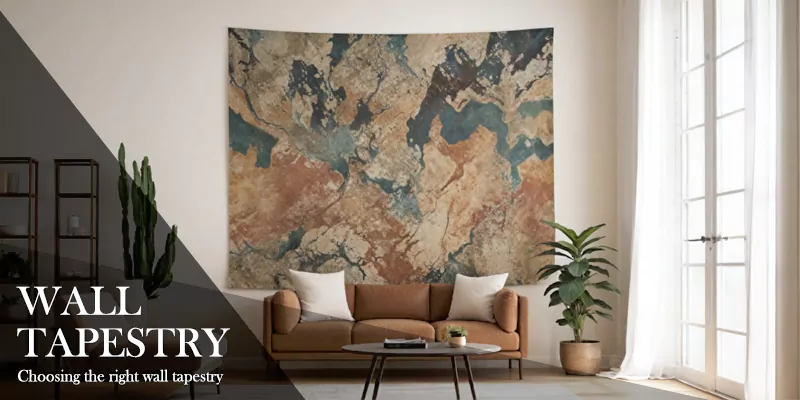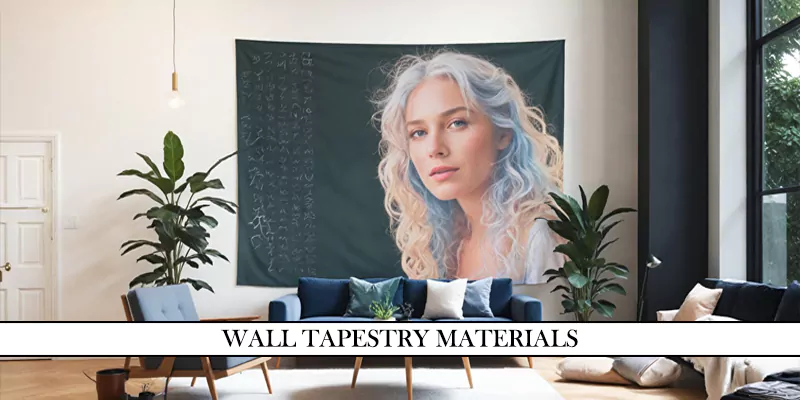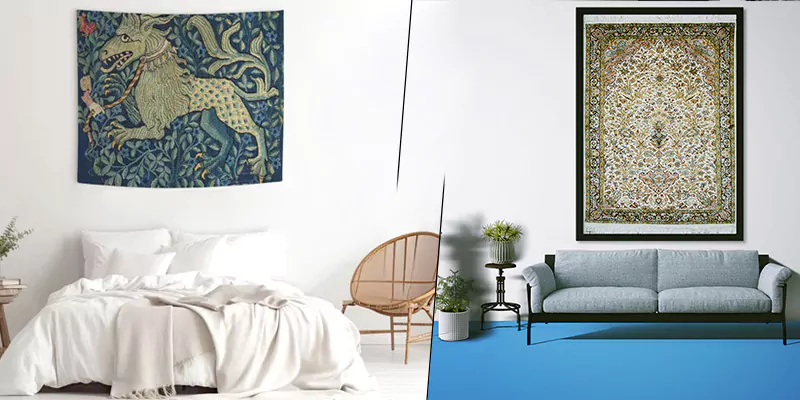- Abe
- Art Gallery
- 520 views
- 0 comments
Wall tapestry is different from ordinary wall painting art, which provides viewers with an artistic experience with both beauty and function. Regardless of whether the fabric wall hanging is woven, simply a cloth wall hanging, or even more of a decorative wall hanging, there is a certain level of consideration that needs to be put into choosing the perfect piece for your home.

How to Choose the Right Wall Tapestry
Here, we will elaborate on the things that you need to consider when choosing a tapestry wall art, the tapestry material and the subtleties regarding size and positioning of your decorative wall tapestry. Also, it will look at the various forms of wall tapestries, the differences between the wall tapestries and other types of wall décor such as wall rugs.
From sizing and positioning tips to installation tips you’ll find guides on how to select and where to place the best tapestry wall hanging for your area, which will not only be part of your home decor but a piece of art that you can affirm your personality from.
Cyrus Crafts; Luxury & Unique Products
Wall Tapestry Location
When selecting a wall tapestry, understanding the space where it will be displayed is important. This includes considering the dimensions and the ambient lighting to ensure that the tapestry enhances the environment without overwhelming it.
Wall Tapestry Measurements
Another limitation that must be adhered to is the size of the wall as well as the furniture arrangement on which the tapestry is to be hung. According to professional designers, the rule of the tapestry should be approximately 60 – 75 percent of the usable wall area over a piece of furniture.
Determines the length and height of the area that is to be decorated and then multiply the two to get the area in meters. This proportion contributes to the general equilibrium in the room, ensuring that the place does not seem overly full of furniture or, on the contrary, almost empty.
Tapestry Lighting Considerations
The impact of the light in the room has a very major influence on the perception of the tapestries. Tapestry and other pieces of art are best exposed to natural light that is they should be hung where they will be lit naturally so that the natural beauty of the texture and the colors of the tapestry, for instance, is brought out. Artificial lighting is an option to make sure the appropriate kind of lighting will be used in order to effectively light the tapestry.
Light placement should be done in a way that there is no glazing on the surface of the tapestry and to also enhance the carving on the wall hanging tapestry. It could be ceiling lights, attached lights, or track lights. The right kind of lighting can boost the added value of the wall tapestry and make it stand out from the rest of the home decoration.

Selecting the Right Tapestry Material
What material to select is again a crucial factor; for it is important to understand the characteristics of the different fabrics used in a wall tapestry. Fabrics including 100% cotton are advised because of their closely knitted weave that provides a perfect ground for painting as well as the display of bright colors.
Fabrics that are loosely threaded or woven may take a higher volume of the paint hence several layers are needed to achieve the standard result.
If you struggling with gifting an artist friend or someone who just love art make sure you read this oil painting gifts related article...
Wall Tapestry Size and Placement Tips
As for the wall tapestry, the size should be selected to be from half to three-quarters of the width of the particular wall or the item of furniture that is to be covered by the hanging. For instance, if one has a couch of the dimensions 84 inches wide, then the appropriate width of the tapestry should range from 42-63 so that it creates a balance. Similarly, for a blank wall with the width measured approximately 108 inches, an ideal tapestry to be hung would be one of approximately 60 inches wide, thus following the “three eights rule”, which puts the idea that approximately 3/8 of the width of the wall on each side would remain the same.
Tapestry Placement Strategies
The layout of a tapestry greatly influences the aesthetic quality of the place where it is installed. For instance, wall hangings such as the tribal design are more appropriate when placed over fireplaces and the recommended dimension between the tape and the fireplace depends on the width of the opening, not the mantel.
If you want to know the appearance of the wall after placing the tapestry, you can draw a line around the desired area with a piece of paper with the size of the wall tapestry, although temporarily. This specific technique assists one in touching the feel of how the location and dimensions of the tapestry will complement the room. Also, proper positioning of the wall tapestry where the eyes of the observer meet the artwork or slightly above it will improve the outlook of the work and attract attention.
Wall Tapestry Installation Tips
There are several methods of putting a wall tapestry; this depends on the material of the tapestry and the walls to be covered. For lightweight wall tapestries, simple as pushpins or adhesive hooks may be efficient enough in hanging these wall arts.
For those rare cases of tapestries with loops on the reverse, it is suggested that pushpins are ideal for use since they do not cause much damage to the walls. When seeking a more secure hold, particularly in cases where wall damage is inevitable such as in a rented building, adhesive hooks or Velcro tape gives a good hold without having to mar the walls.
Heavier wall tapestries should be supported by a rod or a wooden frame. If the pocket is presented in the tapestry, you have to pass a rod through it and suspend it on wall brackets so the weight is balanced. Or fix the four corners of the tapestry to a frame and then pull the staple gun to make the tapestry wall art flat and tight against the wall, for the appropriate look.

Wall Tapestries Vs. Wall Rugs
The roles of the wall tapestries and the wall rugs have been quite central in interior design and decoration for many years and aside from beautifying the walls, both elements were known to serve other useful functions including warmth and acoustic control. Hence, although they are similar in many ways, it is the functions and materials that separate them in many areas of home decoration.
Tapestries are most commonly assigned the function of ornamentation and act as the hanging masterpieces on walls adding to the aesthetic value of a room through their detailed artwork and bright colors. Some of them can strike an historical or cultural narrative woven into the fabric thus having a dual purpose. Nevertheless, some wall decorative tapestries are sensitive to sunlight and quickly fade if they are set close to the window.
Wall rugs are also designed to act as wall decorations hence they are able to withstand the rigor of floor use. Handmade wall rugs are usually made of sterner materials such as wool and silk. In contrast, wall rugs normally have a thicker warp so that they are durable and their coarser nature makes them suitable for fine detailed rooms.
Wall Tapestry Maintenance
For a tapestry to last long and remain rigid you need to wash them on a regular basis to ensure that they are in a good position. Wall tapestries’ maintenance is easy and entails not exposing the tapestry art to direct sunlight in order to fade the colors. Further, regulating a constant level of humidity as opposed to the fabric getting too dry or too wet may also harm it. For the tapestries which are not displayed on the wall, it is recommendable to roll them with the design part inside rather than folding them since this will cause some stress on the fabric.








Comments (0)